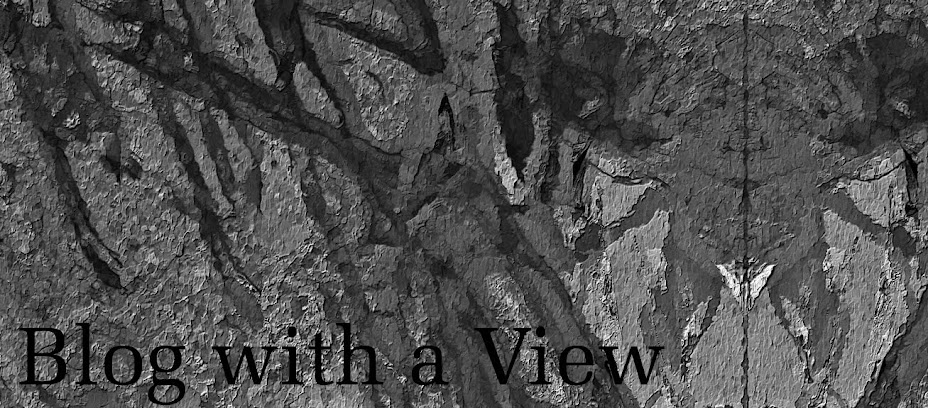More Memories of South Dakota (2002)
I sometimes enjoy making images about places I've lived or seen. I suppose they are like fractal landscapes or still lifes.
I grew up in South Dakota, and the sensations of open space, big sky, and winter wind are still very vivid to me. I saw buffalo as a kid, although they were few in number and confined by fences. Still, if I squinted, I could almost picture herds thundering across the prairie. And, of course, through art, I can actually make them re-appear.
From Buffalo of South Dakota -- a lesson for elementary school children:
European explorers gave the American bison the name of buffalo. Spanish conquistadors thought they looked like cattle. French fur traders called them les boeufs (la buff). Les boeufs is French for "the beefs." English explorers had a hard time saying the French name. They said "la buff" or "buffle." Finally, everyone was saying "buffalo." It became the animal's common name.
Zoologists believe that European bison came to North America long ago. The animals crossed a land bridge between Alaska and Russia. It was nearly 800,000 years ago. The buffalo can adapt to different climates and grasses. They learned to live anywhere in North America. They really liked the grasslands of South Dakota.
Buffalo and beef cattle are alike but not the same. Buffalo get bigger than cattle. But they eat less food than cattle. Buffalo also like dry areas like the Great Plains. They can eat plants that cattle will not eat. Buffalo dig through snow to reach the grass. They can get their water from eating snow. They have thick coats. They can live through blizzards. A buffalo points its body into the wind. It lets bad weather pass it by.
Buffalo have not been domesticated. They are still wild animals. They cannot be tamed like 4-H heifers or steers. Buffalo look lazy and slow. Not so. They can outrun and outmaneuver a horse. Remember this fact if you ever get close to a buffalo.
And what the kids probably don't go on to read is this -- from Nature: American Buffalo --
"The Indian was frugal in the midst of plenty," says Luther Standing Bear, a member of the Lakota tribe. "When the buffalo roamed the plains in multitudes, he slaughtered only what he could eat and these he used to the hair and bones." Indeed, for thousands of years the huge bison herds were able to accommodate the loss of the relatively few animals taken by Native Americans. In the 1500s, however, things began to change. First, Spanish explorers introduced horses to the region. By the 1800s, Native Americans had learned to use the speedy steeds to chase bison, dramatically expanding their hunting range and effectiveness. Next, guns made their way into the hands of buffalo hunters, making them increasingly deadly hunters. But it was that arrival of vast waves of white settlers in the 1800s -- and their conflict with the Native American residents of the prairies -- that spelled the end for the buffalo. Among the earliest waves of settlers were trappers and traders, people who made their living selling meat and hides. By the 1870s, they were shipping hundreds of thousands of buffalo hides eastward each year: more than 1.5 million were packed aboard trains and wagons in the winter of 1872-73 alone.
The commercial killers, however, weren't the only ones shooting bison. Train companies offered tourists the chance to shoot buffalo from the windows of their coaches, pausing only when they ran out of ammunition or the gun's barrel became too hot. There were even buffalo killing contests. In one, a Kansan set a record by killing 120 bison in just 40 minutes. "Buffalo" Bill Cody, hired to slaughter the animals, killed more than 4,000 buffalo in just two years.
"Buffalo" Bill Cody
he was a handsome man
and what i want to know is
how do you like your blueeyed boy
Mister Death
--E. E. Cummings, "Buffalo Bill's defunct"Some U.S. government officials even promoted the destruction of the bison herds as a way to defeat their Native American enemies, who were resisting the takeover of their lands by white settlers. One Congressman, James Throckmorton of Texas, believed that "it would be a great step forward in the civilization of the Indians and the preservation of peace on the border if there was not a buffalo in existence." Soon, military commanders were ordering their troops to kill buffalo -- not for food, but to deny Native Americans their own source of food. One general believed that buffalo hunters "did more to defeat the Indian nations in a few years than soldiers did in 50." By 1880, the slaughter was almost over. Where millions of buffalo once roamed, only a few thousand animals remained. Soon, their numbers dwindled, with the largest wild herd -- just a few hundred animals -- sheltered in the isolated valleys of the newly created Yellowstone National Park.
The memories are still there -- stored on an aging retrieval system in the collective unconscious. And, sometimes, as with today's image, they leak out.

No comments:
Post a Comment